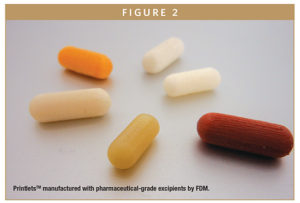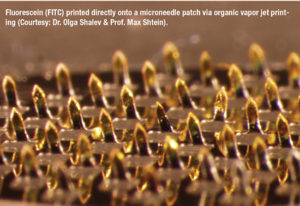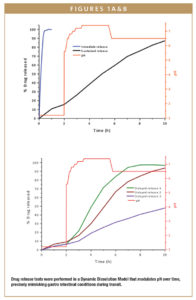Issue:March 2018
3D PRINTING - 3D Printed Drugs Hold Great Potential for Personalized Medicine
INTRODUCTION
This past year marked a milestone in the pharma industry when Aprecia Pharmaceuticals’ Spritam®(levetiracetam) tablets became the first FDA-approved prescription drug product manufactured using 3D printing technology.
“As we explored potential applications for our 3D printing technology in prescription drug products, it was important that we identified disease areas with a real need for patient-friendly forms of medication,” said Don Wetherhold, CEO of Aprecia, in a printed statement.
Spritam is formulated with Aprecia’s proprietary ZipDose®Technology, which combines the precision of 3D printing and formulation science to produce rapidly disintegrating formulations of medications. An inkjet printing process produces the porous water-soluble drug layer by layer by printing aqueous fluid onto layers of powdered medication, without compression or traditional molding techniques, explains Sonia Mannan, Commissioning Editor,Journal of 3D Printing in Medicine. She says researchers from University College London’s School of Pharmacy are using hot-melt extrusion to 3D print different shaped drugs to explore the connection between drug geometry and drug release.
“It’s exciting to see the ways 3D printing is being used in the medical environment,” says Laura Dormer, Editorial Director for Future Medicine, publishers ofJournal of 3D Printing in Medicine. “To date, this has predominantly involved printing of plastics and metals, such as surgical planning, prosthetics, or reconstructive surgery. Surgeons are now able to 3D print accurate models of their patients’ organs, allowing them to plan complex procedures with a higher degree of confidence than with imaging alone. 3D printing has also been used to create tailored bone inserts for use in complex facial reconstructive surgery. 3D printing of pharmaceuticals is less advanced, but offers an exciting opportunity for the future, as does the possibility of printing with organic materials (bioprinting) for use in regenerative medicine.”
PERSONALIZED MEDICINE THROUGH 3D PRINTING
One area of 3D printing that also holds exciting promise is in personalized medicine. As new drugs are developed that have increasing potency and differential effects within populations, there is a need to consider new manufacturing methods and novel supply chains to realize the paradigm of personalised medicines. 3D printing offers the possibility of creating a personalized medicine system through automated control over drug dose and is suitable for both low and high drug concentrations.
FabRx is a research-driven specialist biotech company, focused on developing 3D printing technology for fabricating pharmaceutical dosage forms and medical devices. FabRx was founded in 2014 as a spin-out from University College London (UCL) and operates from the UCL School of Pharmacy, giving the company access to the latest equipment in 3D printing and analytical technology. The company also develops formulations and printing technologies for third-party organizations.
“Our team has a wealth of experience in all aspects of oral drug formulation and knowledge of the challenges of bringing new medicines through the (often complex) regulatory processes of the pharma sector,” says Prof. Simon Gaisford, Printing Technology Director at FabRx. “We are developing printable formulations for personalized drug delivery, and as part of this we are adapting printing technology.”
FabRx has specialist experience in using all the 3D printing technologies that can be used in pharmaceutics, but focuses particularly on fused deposition modelling(FDM), powder bed printing, and stereolithography(SLA) to formulate 3D printedmedicines. Its proprietary 3D printed medicinesare called PrintletsTM.
“These are novel drug formulations that achieve personalized dose and controlled drug release profiles that can be tailored to the individual needs of each drug and that cannot readily be prepared by other manufacturing methods,” says Dr. Alvaro Goyanes, Director of Development at FabRx. “Printlets technology offers a proprietary platform technology to formulate and manufacture 3D printed medicines with nearly any drug compound with a high control of the dose strength (the main requirement for personalization). FabRx technology allows manufacturing of Printlets with a diverse range of shapes, sizes, colors, textures, and flavors to make them more attractive to various patient groups, particularly the young or the elderly, facilitating compliance of the treatment.” Additionally, he says it is possible to incorporate multiple drugs within one Printlet, to make fixed-dose combinations.
Selection of the excipients or the dosage form design means the time of release and/or the release kinetics of each active can be finely tuned. FabRx can fabricate Printlets with a range of GRAS pharmaceutical excipients. Proper selection of excipients allows FabRx to design Printlets possessing any desired drug release profile, ranging from immediate release to sustained and delayed release (including zero-order).
“3D printing could be used to customize specific drugs or drug cocktails based on an individual, but if you want to take it another step further, we could see a future where diagnostic and genomic sequencing technologies are interoperable with the 3D printer to automate calibration and production of the drug for a given individual,” says Reenita Das, Transformational Health Partner and Senior Vice President, at Frost & Sullivan. “One-size-fits-all is not a model that is not ideal for healthcare where you have such a wide spectrum of individuals based on age, height, weight, gender, ethnicity, hereditary traits, co-morbidities, disabilities, etc. The core value driver of 3D printing is the ability to allow for mass customization at scale. 3D printed drugs offer the ability to individualize dosing, tailor drug release profiles, drug combinations, and optimize the supply chain for certain hard-to-get therapeutics.”
 “3D printing could give rise to personalized medicine where medication can be customized to an individual’s needs to make it more effective and safer,” says Ms. Mannan. “This means many aspects of thedrug can be customized to better suit theindividual, such as size and dosage. Drugscan also be designed to have a specificrate of delivery or be designed to be absorbedfrom the intestines or mouth ratherthan stomach.”
“3D printing could give rise to personalized medicine where medication can be customized to an individual’s needs to make it more effective and safer,” says Ms. Mannan. “This means many aspects of thedrug can be customized to better suit theindividual, such as size and dosage. Drugscan also be designed to have a specificrate of delivery or be designed to be absorbedfrom the intestines or mouth ratherthan stomach.”
Researchers believe in the future there could even be the possibility for community pharmacists to tailor and print out customized drugs, adds Ms. Mannan. However, while 3DP has the potential as a point-of-dispensing manufacturing technique, Dr. Goyanes says current technology cannot be used to manufacture medicines for human use. “Today, medicines are usually manufactured in large-scale processes, which limit the range of dose strengths available. “3DP technology will be rapidly developed, optimized, and adapted to pharmaceutical manufacture. The technology will allow fabrication of individual tablets to pharmaceutical quality standards and will enable the dose in each tablet to be verified within situanalysis — the key legal requirement for a medicine to be dispensed.”
During a TED talk, Prof. Lee Cronin, a chemist at the University of Glasgow, took the concept of individual manufacturing one step further, describing a prototype 3D printer capable of synthesis of chemical compounds. It would then be possible to take a digital blueprint and the materials needed, and then synthesize the drug on demand. In the future, Prof. Cronin suggests that some drugs could be instead made available as blueprints, with the materials effectively allowing drug apps to be used.1
MORE FDA APPROVALS REQUIRE AGENCY UNDERSTANDING
Like devices made using other manufacturing processes, devices made using 3D printing technology are subject to regulatory requirements. In 2016, the FDA issued draft guidance on the Technical Considerations for Additive Manufactured Devices to advise manufacturers who are producing devices through 3D printing techniques. The draft guidance provides manufacturers with recommendations for device design, manufacturing, and testing considerations when developing 3D printed devices.2
“The FDA is currently updating the regulations on medical products and is conducting research to advance regulatory science, as well as act as a resource to promote 3D printing and protect public health,” says Freya Lesak, Editor and Community Manager, 3DMedNet, a networkthat unites all members of the diverse communityof 3D printing for medicine.
 “However, further clarity is required on how the FDA and other regulatory agencies will regulate the production of 3D printed drugs (and medical devices).”
“However, further clarity is required on how the FDA and other regulatory agencies will regulate the production of 3D printed drugs (and medical devices).”
The FDA’s Center for Drug Evaluation and Research established an Emerging Technology Team (ETT) to examine and advance applications for new technologies, including 3D printing. “What makes this approach novel is that this dialogue can occur during early technology development prior to the submission of a drug application to the FDA,” says Jeremy Kahn, FDA Spokesperson. “Such early engagement enables the FDA to proactively identify and address potential roadblocks and helps eliminate potential delay in the adoption of promising new technologies.”
The FDA issued a draft guidance in December 2015 entitled Advancement of Emerging Technology Applications to Modernize the Pharmaceutical Manufacturing Base that provides recommendations to pharmaceutical companies on effective ways to work with the ETT.
“The main issue with any chemical that is made is purity, ensuring that there are no byproducts,” says Prof. Cronin. “The standards in big manufacturing facilities are very high — a key question is how this could translate to lots of smaller facilities.”
The FDA is becoming increasingly knowledgeable about 3D printers, and there is interest in how 3D printing can change the way drugs are delivered through implants and other means, says Sarah A. Webster, Global Marketing Director, EnvisionTEC, Inc. EnvisionTEC offers 3D printers that use a variety of technologies to build objects from digital design files. In fact, the FDA is using the EnvisionTEC 3D-Bioplotter ManufacturerSeries model to better understand the 3DP technology. The 3DBioplotteris an open source-materials 3D printer to ensure thatthe printers can build objects according to all customers’ needs.
“Our 3D-Bioplotter is the most popular bioprinter in the world and is used by medical researchers to print biologic materials and do testing with drugs directly embedded in structures that sometimes involve living tissues,” she says. “Combining drugs with implants and living tissue for release in the body is an area of increasing interest and has obvious potential therapeutic value in terms of improving outcomes with implants or organ donation.”
Whether using 3DP to print individual drugs or drugs used with implants, industry insiders say the industry shouldn’t get too far ahead of itself. “Regulators will need to adapt to and accept printing as a method of manufacture,” says Dr. Goyanes. “The approval of Spritam has shown that this is possible, although the market is not yet at the point to accept individual manufacture of medicines at the point of dispensing. However, we believe we will be able to develop and commercialize printed tablets within the next 5 to10 years.”
“I believe over the next 5 years we will continue to see a few select technologies with lower risk profiles achieve regulatory clearance, whereas some of the more advanced applications will move from proof-of-concept and academic research on a path toward commercialization,” agrees Ms. Das. “The approval of Spritam was a significant first step that opens the way from which other, more complex concepts can build. Other developers can now move forward with greater confidence that there is a pathway for their concepts to achieve regulatory clearance. I believe we were amazed at the magnitude and pace at which 3D printing has been adopted and leveraged in other industries. In healthcare, we are just scratching the surface and expect that we will see a similar level of disruption over the next 5 to 10 years.”
REFERENCES
1. Can you 3D print drugs? By Chris Gayomali, The Week, June 26, 2013,http://theweek.com/articles/462825/3d-print-drugs.
2. FDA’s Role in 3D Printing,https://www.fda.gov/MedicalDevices/ProductsandMedicalProcedures/
3DPrintingofMedicalDevices/ucm500548.htm.
SIDEBAR
VAPOR PRINTING COULD TRANSFORM DRUG DELIVERY
Researchers at the University of Michigan have invented a vapor printing technique they say can print precise doses of multiple drugs onto a variety of surfaces and could possibly revolutionize personalized medications and diagnostics.
Lead researcher Max Shtein, Professor of Materials Science and Engineering, explains the process of organic vapor jet printing (OVJP): It proceeds by thermally evaporating the substance (API) into a stream of inert carrier gas (eg, nitrogen), followed by jetting onto a substrate, where the API forms a film. The organic material is evaporated into a carrier gas; the mixture of evaporated material and carrier gas is jetted onto the cooled substrate, where the organic material condenses. The process is controlled via several parameters, which regulate the deposition rate, the deposit shape, as well as the resulting film morphology.
“There are a number of possible ways in which our technology could transform drug delivery,” he says. “If a medicine is taken by mouth, it can be printed onto tablets, onto dissolvable film, or even directly into a liquid or gel capsule. His co-author Dr. Olga Shalev adds: “And for medicines administered primarily by injection, many of those exhibit poor bioavailability. Their active ingredient is often a small organic molecule, as in many cancer medications. We printed a variety of different medicines, including some cancer drugs and observed improved bioavailability of cancer drugs printed with vapor jet printing as compared to the conventional drug powder. This suggests there is indeed great potential to replace some of the injections with printed drug films.”
 Dr. Shtein points out that vapor printing can be easily adopted by pharmacies and hospitals with just a vapor jet printer, along with the ingredients pre-packaged in cartridges, not unlike a home or office printer. “Of course, this would have to be done in a tamper-proof and traceable way, and cost effectively to attain affordable, yet personalized medications,” he says.
Dr. Shtein points out that vapor printing can be easily adopted by pharmacies and hospitals with just a vapor jet printer, along with the ingredients pre-packaged in cartridges, not unlike a home or office printer. “Of course, this would have to be done in a tamper-proof and traceable way, and cost effectively to attain affordable, yet personalized medications,” he says.
Vapor printing and 3D printing are both additive manufacturing techniques, but in the case of vapor printing, the researchers explain that the material goes down onto a surface from the bottom up, layer by layer. “In the case of 3D printing, there are usually additional substances (such as polymers and/or solvents) involved. With our method, we obtain a coating that contains pure medicines, and none of those unwanted additives. Some have used 3D printing to print actual pills, but in our case, the active ingredient can be coated onto almost any surface/object you need. For oral use, for instance, you can use a sugar strip; for transdermal use, you can coat it onto needle or patch, etc.”
Interestingly, 3D and vapor printing techniques can be combined. As vapor printing enables printing on almost any surface, any small molecular medicine can be printed on a 3D printed object. As there are no pre- or post-processing steps needed, development time is shortened, he says.
“The medicines can be printed with very high, nanogram accuracy,” adds Dr. Shalev. “This means that we can use the technique not only for therapeutics but also for certain kinds of diagnostics. This accuracy would be very difficult to achieve with 3D printing. We can combine different ingredients, and the system is highly controllable and can be very precisely calibrated to deliver the exact amount needed, very consistently.”
REFERENCE
1. Shalev, Olga, et. al., Printing of small molecular medicines from the vapor phase,Nature Communications, http://www.readcube.com/articles/10.1038/s41467-017-00763-6.
Total Page Views: 13787


















